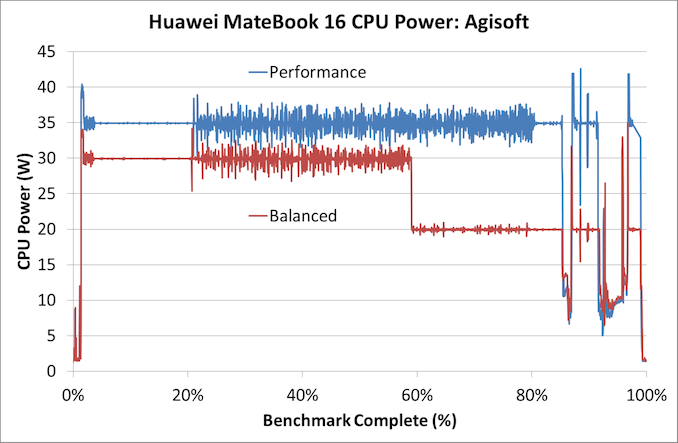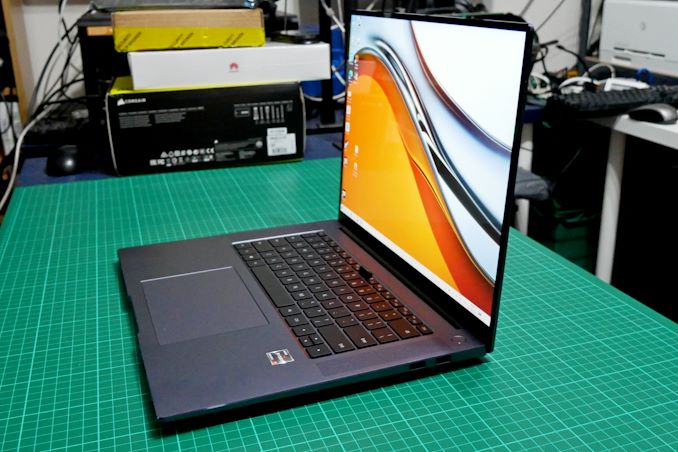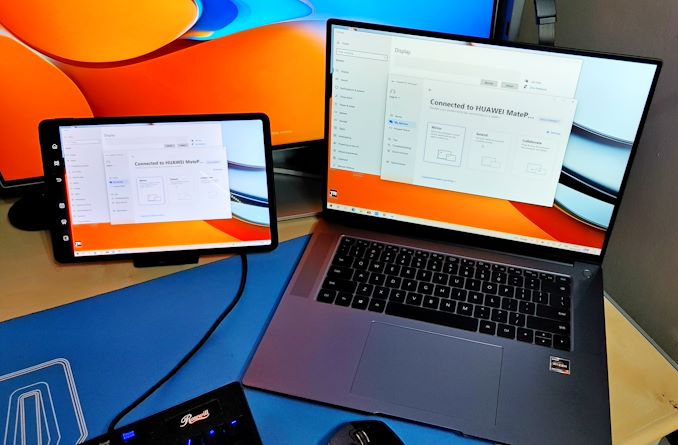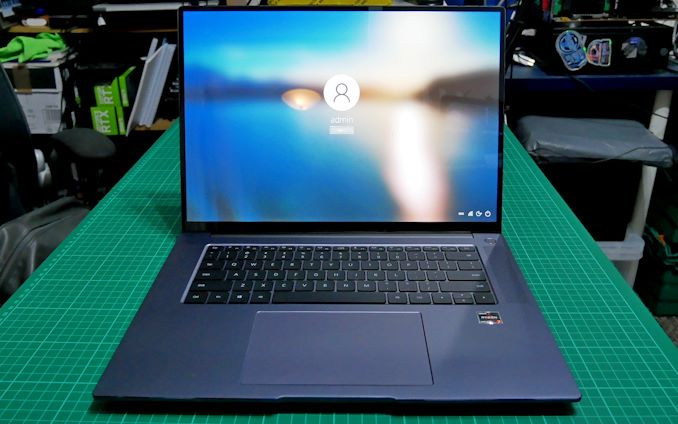The Huawei MateBook 16 Review, Powered by AMD Ryzen 7 5800H: Ecosystem Plus
by Dr. Ian Cutress on October 20, 2021 8:00 AM EST- Posted in
- Laptops
- AMD
- Huawei
- Matebook
- Ryzen
- Zen 3
- MateBook 16
- Huawei Share
- Ryzen 7 5800H
Huawei: Building its Ecosystem
From the 30000ft view, I’m a fan of notebooks that promise good power and battery life at the expense of graphics. As a journalist, when I’m on the move I need something that’s going to be easy to carry, easy to work on, and has enough juice to last me through the day. Naturally, some might think that I should pivot to one of the Snapdragon or Chromebook devices, but alas I have some software in my daily toolset that doesn’t work on either, so until then, I’m still focused on devices built with AMD or Intel.
With that brief, the MateBook 16 on paper fits the bill. It’s a 16-inch device that shuns discrete graphics in favor of a larger battery, lighter unit, and slimmer design. The IPS display is an odd resolution (2520x1680), but the 3:2 aspect ratio is appreciated for the sort of text-heavy writing and research I tend to do. It has Type-C and Type-A ports, a full-sized HDMI port, a large smooth trackpad, and an off-center power button with an excellent fingerprint sensor inside. So it’s a shame that the pop-up camera makes for nasal meetings. Overall, at 2 kg, it isn’t the lightest in its segment (the LG Gram 17 is 1.5kg), but it is half the price, and comes with a 45W-class processor.
When the CPU Isn’t What You Think It Is
So here’s where we get into some of the discussions around performance. The Ryzen 7 5800H is a good choice for this class of device: eight Zen 3 cores at high frequency with Vega 8 graphics. While the graphics aren’t great for regular 16-inch devices that often have discrete graphics, the CPU has grunt. However, the Ryzen 7 5800H is a 45W-class processor, and so reading a specification sheet you would expect that level of performance. Huawei runs the processor at 35W instead, which is well within the spec for this part, however nowhere on the box does it say as much. There are tradeoffs with the lower power setting, such as slightly reduced performance in exchange for some battery life, but also less dependency on cooling and a lighter chassis. Huawei does offer a performance mode, when the charger is plugged in, however this just means the 35W mode is infinite, whereas in regular mode (unplugged or plugged in) may only stay at 35W for a limited time based on temperature/efficiency.

Performance was 6% quicker to complete over 20 minutes
So if you were to buy this laptop, or any laptop for that matter, should you expect the processor to run at the power given by the processor manufacturer? Almost every laptop processor is offered to the laptop manufacturer with a configurable power option, allowing them to optimize for the chassis design. If it is adjusted from the CPU default, then should the customer know about it? As of right now, and every OEM is guilty of this, no laptop ever mentions when the CPU is configured for the chassis at a lower specification point than the default.
This drives me somewhat insane, as someone who likes to know exactly what performance I’m getting from a device. Now it might seem a bit oblique to talk about this specifically during one particular review, but it’s an endemic problem across all laptop manufacturers. It wouldn’t take much to say ‘Device X (35W)’ in the specification page. Unfortunately sometimes the people writing those specification pages for retail or for websites aren’t connected to the engineers tuning the device at all. So we’re left with automatically assuming the processor manufacturer specifications, which in this case, isn’t correct.
The plus side, I guess, is that laptops should be reviewed to know their real performance!
Huawei MateBook 16
The goal of the MateBook 16 seems to be that it offers one tool for anyone investing in Huawei’s ecosystem, combining laptop, smartphone, tablet, or anything else. Using features like the Huawei Share was actually quite easy, to move files, or to extend a workspace. If I already take a laptop and a 13-inch Type-C wired display with me when I go on a work trip, then migrating that display with a wireless connection, as well as doubling it up as a standalone tablet, isn’t so much of a leap. However, when it comes to display sharing or extending, input lag will be a thing for anyone looking to do some gaming.
That being said, the 16-inch size of the unit isn’t ideal when faced with modern-day economy travel. Even as small as I am at 5’5, pulling a 13-inch laptop in an economy seat is sometimes fraught with issues (especially as the person in front leans back and catches your screen, cracking it), let alone using a 16-inch. To get the best in that light, you need to be on a bulkhead seat, or be in a business-class seat.
Therein lies a bit of a dilemma. I would imagine someone using a business class seat that was paid for would have access to $2000-$3000 for a work device. The Ryzen 7 5800H in this review is 1199 Euro or £1000 GBP (USD$1150 pre-tax), which marks it more as an entry-business notebook. As a business device, where graphics aren’t needed and you’re happy with the size, then the MateBook 16 works well with its strong display, CPU, and reasonable battery life, but the DRAM/storage might be limiting. At 16 GB / 512 GB, this does teeter on the barely acceptable limits. But this all combines into that lower cost.
For comparison, at Dell the similar device is the Inspiron 16. Around the same price, it offers the Intel Core i7-11800H, a 16:10 slightly higher resolution screen, same DRAM/storage, similar battery, TB4, full keyboard, but is also slightly thicker for the same weight, and doesn’t have dual front-facing speakers. Lenovo’s IdeaPad Creator 5 16 has the Ryzen 5 5600H, 1600p display, same DRAM/Storage, comes with a GTX1650, and a slightly smaller battery, at around 10% higher cost. This market is bigger than you might think, with most of the major players having at least one offering around this price, and the minutiae come down to exact features vs favoring one brand over another.
Overall, it isn’t the device for the person that I am – it’s just a bit too physically big, and ultimately I can feel the difference between lugging a 2 kg device around a trade show compared to a 1.5 kg device. But for those that it fits, the building blocks are there for a very easy-to-use ecosystem. I wait for a version where Huawei ditches that camera though.













87 Comments
View All Comments
anandcx - Wednesday, October 20, 2021 - link
Gram 17 has 80wh battery, you have linked a two years old model you fool. Since 2020 all Gram 17's have 80wh battery, this is the link for 2021 model: https://www.lg.com/us/laptops/lg-17z90p-k.aas9u1-u...Prestissimo - Wednesday, October 20, 2021 - link
What? Battery is quite small for a 45W CPUbenedict - Wednesday, October 20, 2021 - link
I'm amazed companies keep pushing laptops with 512GB SDDs and pretend they are not crap. 1 TB of storage is the absolute minimum any new pc or laptop should have if you don't want to buy a second SSD in a few months.stephenbrooks - Wednesday, October 20, 2021 - link
I guess people can use them with external drives, but yes, if a laptop or PC has under 1TB of built-in storage it better be priced economically.Tomatotech - Thursday, October 21, 2021 - link
Yup. People don't realise that many SSDs slow down quite a lot as they get full up. My 1TB NVMe SSD is one of these that fold empty TLC space into a SLC buffer. What that means with my particular SSD is that it only runs at max speed up to about 66% full then after that it slows down, as shown in benchmarks and daily feel if it goes over around 650GB full.Practically, I treat it as giving me around 600GB of long-term working storage plus another 350GB of emergency / temporary storage. I knew this before buying it and I'm happy with it, though I would like my next SSD to be 2TB as I'm hovering round the 550GB long term storage mark at the moment.
TheinsanegamerN - Wednesday, October 20, 2021 - link
Not everyone compiles videos from 8k120hz video all day. 512GB is not a hindrance to most. And you can just upgrade it yourself instead of paying a premium to get it pre installed.Prestissimo - Thursday, October 21, 2021 - link
My laptop running W11 has a 128GB SATA 3 SSD and it's blazing fast for everyday tasks. All my data's on my internal storage as well, synced up to Google Drive. We don't need higher capacity PCIe 4.0 SSDs driving up base laptop prices for the general public.Stop speaking for everyone else, it's arrogant and presumptuous.
schujj07 - Thursday, October 21, 2021 - link
If all you aren't storing boat loads of videos, photos, music, or games then 512GB is plenty for OS/Application drive. My work laptop has a 256GB SSD and that isn't an issue as a lot isn't stored on the laptop.fishingbait15 - Friday, October 22, 2021 - link
The people who would buy a device like this are probably 50/50 web cloud and 50/50 local stuff. It doesn't have a dGPU so no AAA gaming and no content creation. People who are doing full stack programming or virtualization would likely opt for CPU with more cores. The days when people had massive libraries of purchased iTunes videos and TV shows are over ... that stuff is streamed now.DominionSeraph - Friday, October 22, 2021 - link
My C:\ drive is using 286GB, 200GB of which is games. Very few people use laptops for much more than internet/office tasks which doesn't even take 50GB if you nuke the hiberfil file. 512GB is overkill for most users.